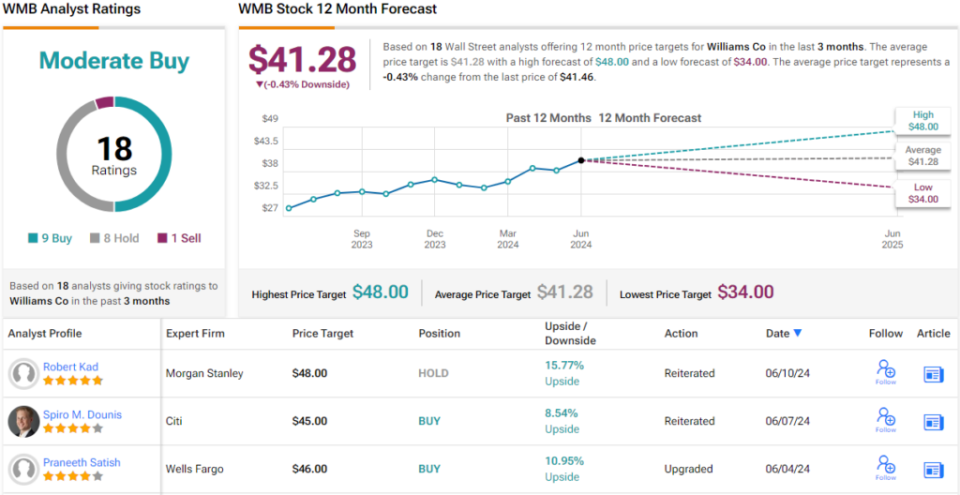At the end of April, natural gas prices at Henry Hub reversed a three-month dip and started heading up again. As a result, natural gas futures prices are now back at the same levels seen at the beginning of this year. The shift in price has triggered a shift in stance, as well. The prospect of stronger pricing and profits, amid a surge in demand, has attracted a round of investor interest in energy stocks.
Covering the energy sector for Wells Fargo, 5-star analyst Michael Blum looks at multiple reasons for taking a bullish view of the energy industry – and he comes down to a simple conclusion: “We see continued multiple expansion for natural gas midstream stocks driven by growing gas demand supported by AI, re-shoring, LNG, etc.“
Blum elaborates further, emphasizing, “Investors typically view midstream capex negatively after having lived through a period of disappointing returns. However, investor psychology on capex could change (at least for natural gas names). As ROIC increases and investors become more comfortable with the visibility of future returns (e.g. tied to data center demand), we believe growth (and capex) could be viewed favorably again. Higher growth rates typically tend to support higher EV/EBITDA multiples.”
Against this backdrop, the Wells Fargo analysts, Blum and his colleagues, are telling investors to pull the trigger on two natural gas midstream stocks in particular. We ran these tickers through the TipRanks database to see what other Street experts make of their prospects.
The Williams Companies (WMB)
We’ll start with Williams Companies, a $50 billion name in the natural gas midstream business. The company got started back in 1908, building pipelines for the expanding petroleum industry. Today, Williams owns and operates a continent-ranging network of natural gas assets, including gathering and storage facilities, pipelines, and processing plants.
This network is centered on the Gulf Coast of Texas-Louisiana-Mississippi, and extends into the Gulf and east to Florida. To the northeast, the company’s network reaches out to the natural gas fields of Appalachia, while to the northwest, it extends through the Plains to the central Rocky Mountains and out to the Pacific Northwest. The Williams Companies has a part in moving approximately one-third of all the natural gas used in the US for cooking, home heating, and electrical generation.
All of this adds up to more than just big business – it adds up to multi-billion dollar business. Williams reported $2.77 billion at the top line in 1Q24, a figure that was down 10% from the prior year but did beat the forecast by $80 million. In other key metrics, the company reported $1.234 billion in cash flow from operations, and reported that it had $1.507 billion in available funds from operations. This latter figure was up 4%, or $62 million, year-over-year.
At the bottom line, Williams had a non-GAAP net income of $719 million, supporting an EPS of 59 cents per share. The per-share result beat the forecast by 10 cents and was up 5% from the prior-year period.
The company’s solid results supported the dividend declaration, which was made on April 30 for a June 24 payout. The dividend was set at 47.5 cents per common share, up 6% year-over-year. The annualized rate of $1.90 gives a forward yield of 4.5%. Williams has a reputation for reliable dividend payouts.
Covering WMB for Wells Fargo, analyst Praneeth Satish sees plenty of reasons why the stock should keep on shining.
“WMB with essentially 100% natural gas exposure is uniquely positioned to benefit from rising domestic power/gas demand over the coming decade via higher pipeline & storage volumes (longer runway for gas demand), higher G&P volumes (longer runway for gas demand), higher E&P profits (potentially higher gas prices LT), and higher marketing profits (more gas price volatility),” Satish opined.
Putting this into concrete terms, Satish upgraded WMB shares from Equal Weight (i.e. neutral) to Overweight (i.e. Buy). Furthermore, the analyst bumps up his price target to $46, suggesting a 13% upside potential in the next 12 months. With the dividend yield added in, the potential return here approaches 17.5%. (To watch Satish’s track record, click here)
So, that’s Wells Fargo’s view, what does the rest of the Street have in mind? The current outlook offers a conundrum. On the one hand, based on 9 Buys, 8 Holds and a single Sell, the stock has a Moderate Buy consensus rating. However, the analysts expect shares to remain range-bound for the foreseeable future as indicated by the $41.28 average price target. (See WMB stock forecast)

Kinder Morgan (KMI)
The second stock we’ll look at here is one of the largest energy infrastructure companies on the S&P 500 index, with an asset network that spans the continental US and a $43.7 billion market cap. The company’s goal is to provide the widest possible access to reliable and affordable energy, and to that end, it…
Source link
This article was complied with AI assistance and reviewed by an editor. More information can be found in our T &C






















